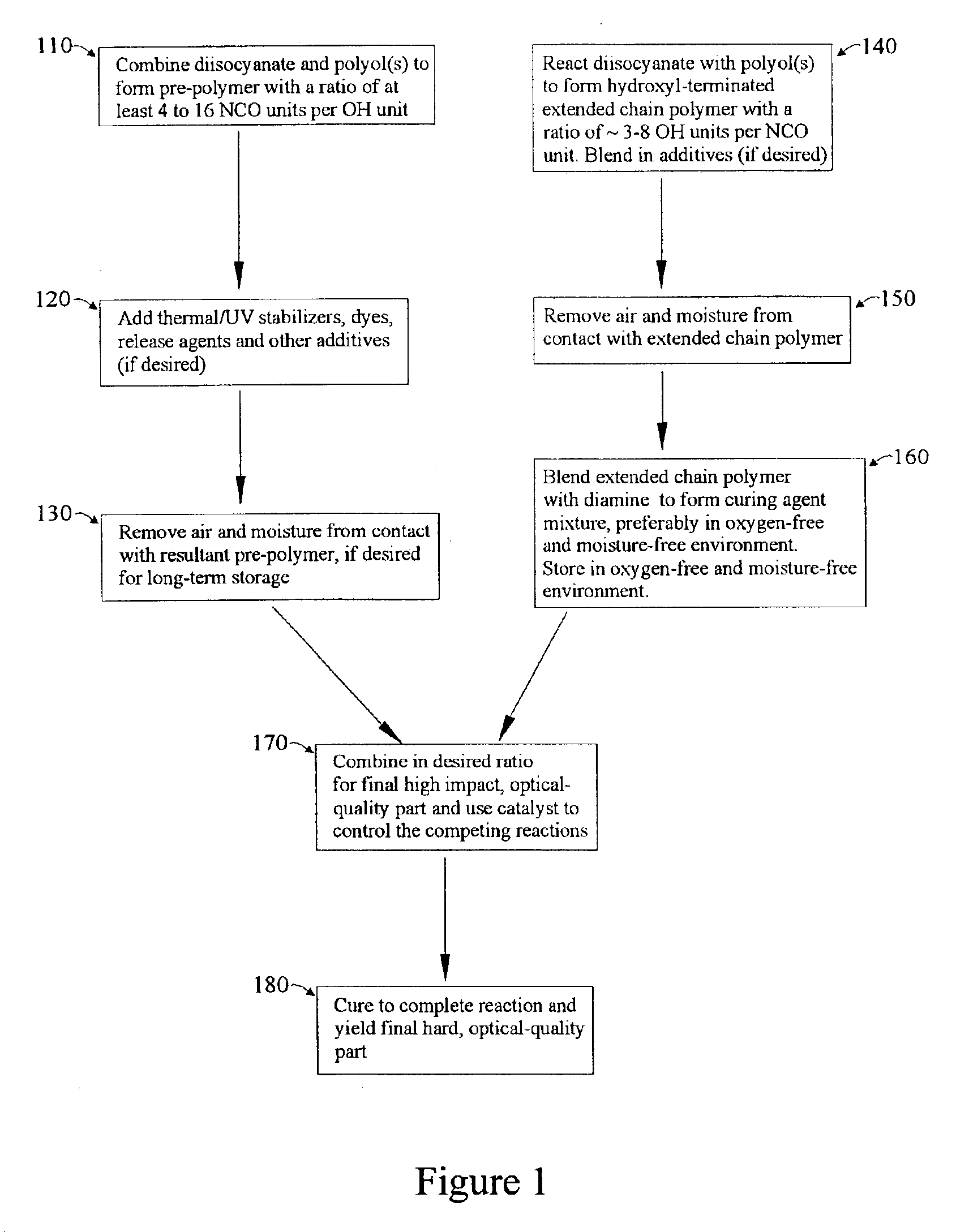Polyurea/urethane optical material and method for making it
a technology of polyurea/urethane and optical materials, applied in the field of polyurea/urethane optical materials and their making, can solve the problems of greater heaviness, worse impact resistance, and trade-offs between these desired characteristics
- Summary
- Abstract
- Description
- Claims
- Application Information
AI Technical Summary
Benefits of technology
Problems solved by technology
Method used
Image
Examples
examples
[0065]Exemplary optical parts were prepared incorporating the material of the present invention using the method described above. The parts then were tested for optical clarity and for impact resistance. Materials used in these parts, as well as additional exemplary materials, are described in Table 1 below.
[0066]
TABLE 1IngredientDescriptionSupplierToneCaprolactone diol prepared from E-caprolactoneDow32B8and 1,6-hexanediol; molecular weight ˜400Chemi-cal Co.ToneCaprolactone diol prepared from E-caprolactoneDow32C8and 1,4-butanediol; molecular weight ˜750Chemi-cal Co.ToneCaprolactone diol prepared from E-caprolactoneDow2221and neopentyl glycol; molecular weight ˜1000Chemi-cal Co.ToneCaprolactone diol prepared from E-caprolactoneDow1278and 1,4-butanediol; molecular weight ˜4000Chemi-cal Co.CAPACaprolactone diol prepared from E-caprolactoneSolvay2302and 1,4-butanediol; molecular weight ˜3000S.A.Des-4,4′-methylenebis(cyclohexyl isocyanate) containingBayermodur ®20% of the trans,trans is...
examples 1 to 5
[0067]Preparation of urethane prepolymer (Component A): 13,599.8 grams of Desmodur W were placed in a reactor equipped with an agitator, temperature controller, and a nitrogen gas purge. The system was warmed to a temperature held between 70° C. and 85° C. to avoid thermal shock when the next reactants were added. The agitator then was started, along with the nitrogen purge. 1,316.6 grams of Tone 1278, 607.5 grams of CAPA 2302, and 1841.1 grams of Tone 32B8, all which had been preheated to 82° C., then were added to the reactor. The reaction temperature was allowed to reach 140° C., at which time the heat source was removed. When the temperature of the reactants fell to 120° C., 278.3 grams of Tinuvin 328, 278.3 grams Lowilite 92, 278.3 grams of Irganox 1010, 10 ppm of Exalite 78-13, and 4 ppm of SF-8843 were added to the reactor. When the temperature of the reaction mixture cooled to 71° C., the reaction vessel was evacuated. The reaction product then was transferred into storage c...
examples 6 to 8
[0077]In Examples 6 to 8 urethane prepolymer and extended chain polymer were prepared as described above in Examples 1 to 5. However, in these Examples, the amount of catalyst added to the curing agent mixture was altered, as shown in Table 3 below, to test the effect of the catalyst on the final product's optical and physical properties. The isocyanate to amine ratio was held constant for each experiment at 1.0:0.94. For these experiments, the mixture of Components A and B was transferred from the reaction vessel into plastic molding cups at room temperature. The mixtures in the molding cups were degassed and then cured at a temperature of 96° C., to form parts approximately 2.75″ (70 mm) in diameter and (25 mm) deep. Observations of these parts are provided in Table 3 below.
[0078]
TABLE 3ExampleCatalyst contentOptical qualityNumberin final productfor 1″ thick samplesObservations6noneopaque blue-whiteMaterial is brittle743.6 ppmtranslucent milky blue8 131 ppmtransparent
[0079]These E...
PUM
| Property | Measurement | Unit |
|---|---|---|
| elongation | aaaaa | aaaaa |
| viscosity | aaaaa | aaaaa |
| temperature | aaaaa | aaaaa |
Abstract
Description
Claims
Application Information
 Login to View More
Login to View More - R&D
- Intellectual Property
- Life Sciences
- Materials
- Tech Scout
- Unparalleled Data Quality
- Higher Quality Content
- 60% Fewer Hallucinations
Browse by: Latest US Patents, China's latest patents, Technical Efficacy Thesaurus, Application Domain, Technology Topic, Popular Technical Reports.
© 2025 PatSnap. All rights reserved.Legal|Privacy policy|Modern Slavery Act Transparency Statement|Sitemap|About US| Contact US: help@patsnap.com

